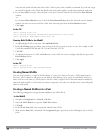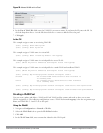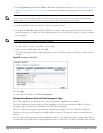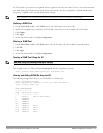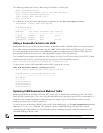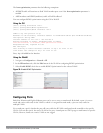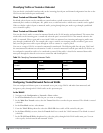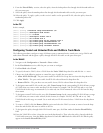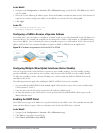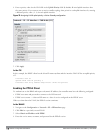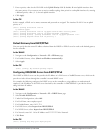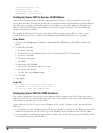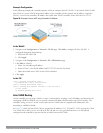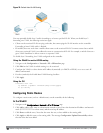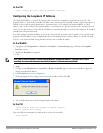
117 | NetworkConfigurationParameters DellPowerConnectW-SeriesArubaOS6.2 | User Guide
11. When you are finished listing VLAN and policies, click Cancel.
12. Click Apply.
In the CLI
(host) (config) #interface fastethernet 2/0
(host) (config-if)#description FE2/
(host) (config-if)#trusted vlan 1-99,101, 104, 106-199, 201-299
(host) (config-range)# switchport mode trunk
(host) (config-if)#switchport trunk native vlan 100
(host) (config-range)# ip access-group
(host) (config-range)# ip access-group test session vlan 2
Understanding VLAN Assignments
A client is assigned to a VLAN by one of several methods. There is an order of precedence by which VLANs are
assigned. The assignment of VLANs are (from lowest to highest precedence):
1. The default VLAN is the VLAN configured for the WLAN (see "Configuring Virtual AP Profiles" on page 315).
2. Before client authentication, the VLAN can be derived from rules based on client attributes (SSID, BSSID, client
MAC, location, and encryption type). A rule that derives a specific VLAN takes precedence over a rule that
derives a user role that may have a VLAN configured for it.
3. After client authentication, the VLAN can be the VLAN configured for a default role for an authentication
method, such as 802.1x or VPN.
4. After client authentication, the VLAN can be derived from attributes returned by the authentication server
(
server-derived rule
). A rule that derives a specific VLAN takes precedence over a rule that derives a user role that
may have a VLAN configured for it.
5. After client authentication, the VLAN can be derived from Microsoft Tunnel attributes (Tunnel-Type, Tunnel
Medium Type, and Tunnel Private Group ID). All three attributes must be present as shown below. This does
not require any server-derived rule.
Tunnel-Type="VLAN"(13)
Tunnel-Medium-Type="IEEE-802" (6)
Tunnel-Private-Group-Id="101"
6. After client authentication, the VLAN can be derived from Vendor Specific Attributes (VSA) for RADIUS server
authentication. This does not require any server-derived rule. If a VSA is present, it overrides any previous VLAN
assignment. For example:
Dell-User-VLAN
Dell-Named-User-VLAN
How a VLAN Obtains an IP Address
A VLAN on the controller obtains its IP address in one of the following ways:
l Manually configured by the network administrator. This is the default method and is described in "Assigning a
Static Address to a VLAN" on page 117. At least one VLAN on the controller must be assigned a static IP
address.
l Dynamically assigned from a Dynamic Host Configuration Protocol (DHCP) or Point-to-Point Protocol over
Ethernet (PPPoE) server.
Assigning a Static Address to a VLAN
You can manually assign a static IP address to a VLAN on the controller. At least one VLAN on the controller must
be assigned a static IP address.



